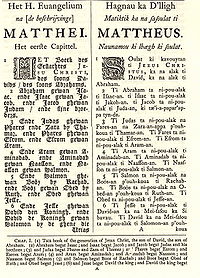
Sinckan Manuscripts
Encyclopedia

History and background

Tainan
Tainan City is a city in southern Taiwan. It is the fifth largest after New Taipei, Kaohsiung, Taichung, and Taipei. It was formerly a provincial city, and in 2010, the provincial city merged with the adjacent Tainan County to form a single special municipality. Tainan faces the Taiwan Strait in...
. During the time when Taiwan
Taiwan
Taiwan , also known, especially in the past, as Formosa , is the largest island of the same-named island group of East Asia in the western Pacific Ocean and located off the southeastern coast of mainland China. The island forms over 99% of the current territory of the Republic of China following...
was under the administration of the Dutch East India Company
Dutch East India Company
The Dutch East India Company was a chartered company established in 1602, when the States-General of the Netherlands granted it a 21-year monopoly to carry out colonial activities in Asia...
, Dutch missionaries learned Sinckan to facilitate both missionary
Missionary
A missionary is a member of a religious group sent into an area to do evangelism or ministries of service, such as education, literacy, social justice, health care and economic development. The word "mission" originates from 1598 when the Jesuits sent members abroad, derived from the Latin...
work and government affairs. They also created a romanized script and compiled a dictionary of the language, teaching the natives how to write their own language.
In 1625, Maarten Sonck, the Dutch governor of Taiwan, requested that the Netherlands send two to three missionaries to Taiwan for the purpose of converting the natives. However, the first group to arrive were visiting missionaries who did not have the authority to perform baptism rites. It was not until June of 1627 that the first real minister, Rev. Georgius Candidius, arrived, upon which missionary work in Taiwan began in earnest. The first area to be targeted, the Sinckan settlement, had many converts by 1630.
In 1636, the Dutch started a school for the Sinckan that not only featured religious instruction, but also provided schooling in Western literature. Because the Dutch advocated missionary work to be done in the native language, the school was taught in the Sinckan language. The missionary Robertus Junius recorded in his 1643 education report that the Sinckan school had enrolled 80 students, of which 24 were learning to write and 8 to 10 had solid penmanship, while in neighboring Baccaluan school there were 90 students, of which 8 knew how to write.
Aside from proselytizing, the missionaries also compiled dictionaries and books of religious doctrine; they translated the Gospel of Matthew
Gospel of Matthew
The Gospel According to Matthew is one of the four canonical gospels, one of the three synoptic gospels, and the first book of the New Testament. It tells of the life, ministry, death, and resurrection of Jesus of Nazareth...
into Sinckan and also compiled a vocabulary of Favorlang, another aboriginal language. These would become important sources for later research. The most important Sinckan documents were the contracts between the Sinckan and the Han settlers, commonly known as the Fanzi contracts.
Although the Dutch only governed Taiwan for 38 years, they greatly influenced the development of indigenous culture. To take the Sinckan Manuscripts as an example, the latest extant documents in the Sinckan script date back to 1813, more than 150 years after the Dutch left Taiwan in 1662.

